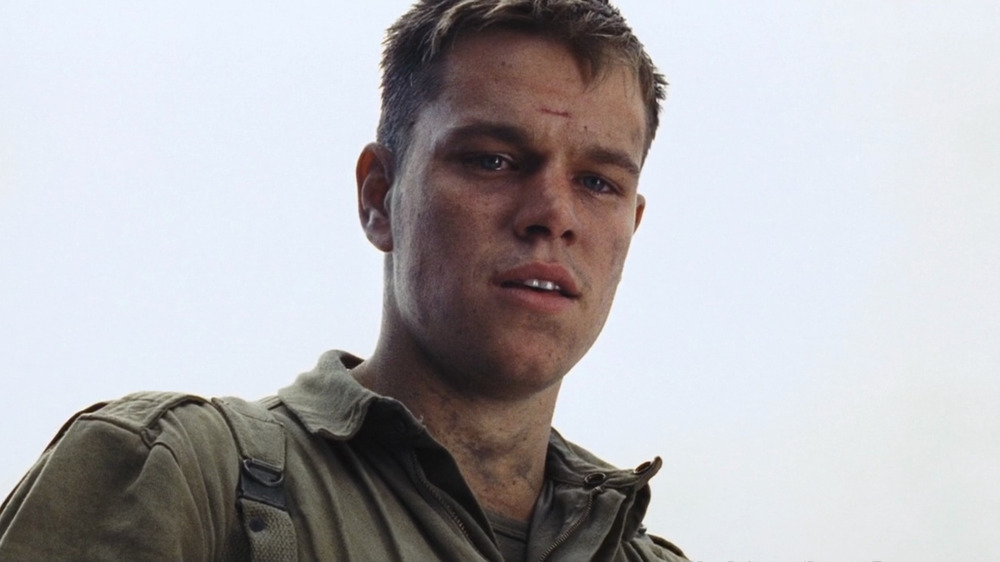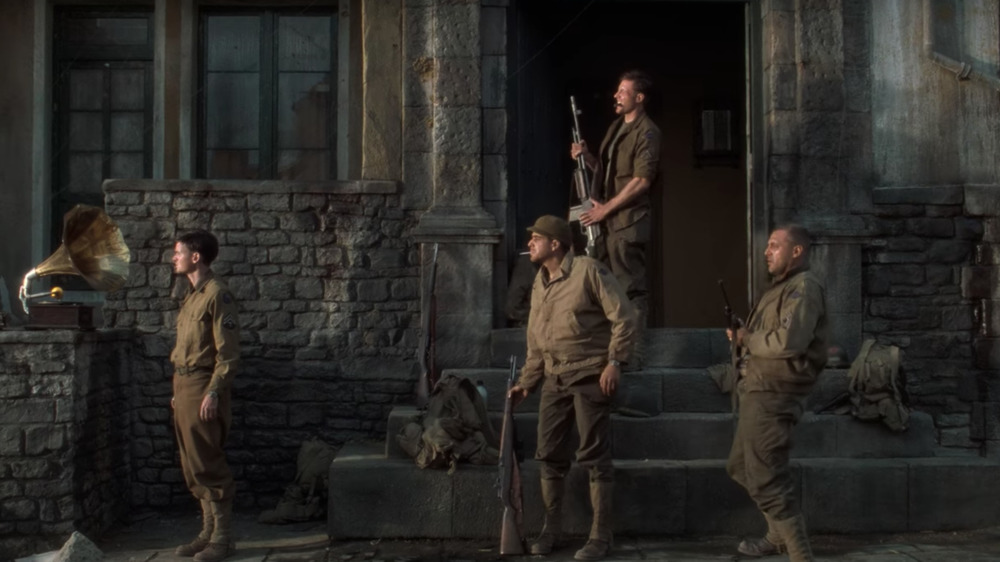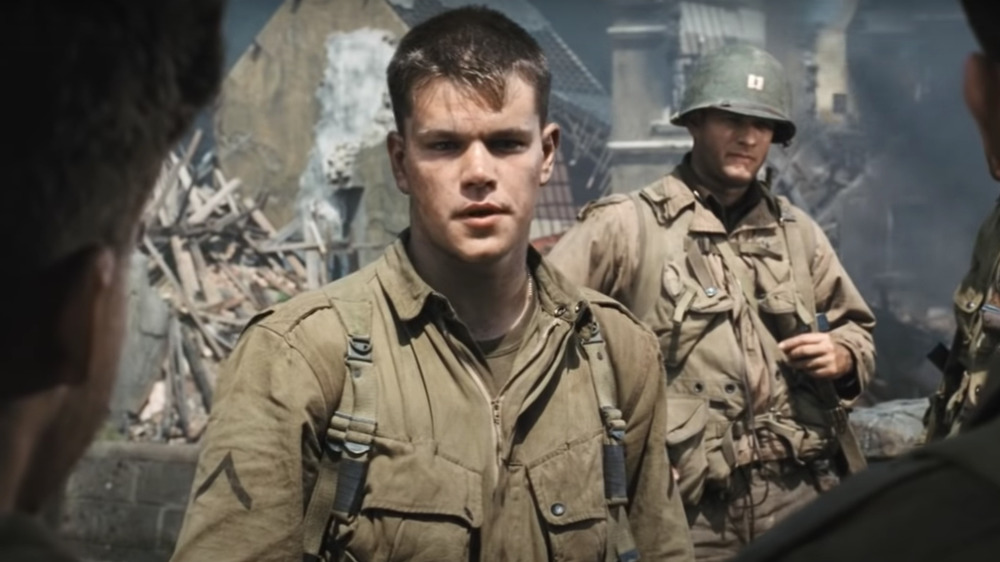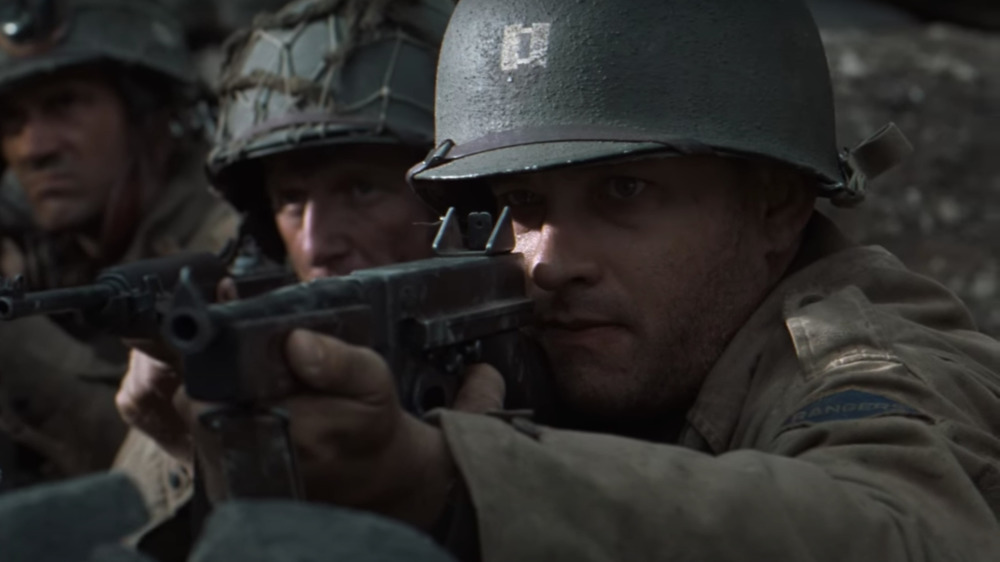Is Saving Private Ryan Based On A True Story?
Over two decades since its theatrical release, Saving Private Ryan still holds up as one of the most celebrated war movies ever made and one of the best films of all time. And it's not hard to see why: The film has a stellar cast, an iconic director in Steven Spielberg, and shockingly realistic depictions of World War II. Saving Private Ryan's opening sequence, portraying the 1944 Omaha beach landing during allied invasion of Normandy, is often regarded by many World War II veterans as one of the most realistic recreations of D-Day as well. One veteran told The Los Angeles Daily News that the scene was so true to life that he could "smell the gunpowder fumes from the cannons, and the heavy diesel engine fumes from all the landing crafts circling the beach."
The movie doesn't shy away from showing audiences the horrors, fears, and the gruesome physical and psychological toll fighting takes on a soldier during war as it tells the story of Captain John H. Miller (Tom Hanks) leading his men on a mission to retrieve Private James Ryan (Matt Damon) after the latter's three brothers are killed in combat. Despite its heavily realistic-feeling scenes from World War II, however, the film's plot and characters are fictional. There was never a Captain Miller, nor was there ever a directive to rescue a Private Ryan from behind enemy lines. That said, though, there are contextual elements of Saving Private Ryan's story that are based in truth.
Private Ryan was sent home based on a real policy enacted during World War II
In the film, James Ryan is the fourth and only Ryan brother still living. When a war department colonel (Bryan Cranston) informs General George C. Marshall (Harve Presnell) of the three brothers' deaths, he says, "All four of them were in the same company in the 29th division, but we split them up after the Sullivan brothers died on the Juneau." Though Cranston's character may be fictional, the events to which he is referring are truthful.
The reason for James' rescue in Saving Private Ryan was based on the "sole-survivor policy" (via History). In 1942, the five Sullivan brothers, all stationed together aboard the USS Juneau, were killed after their cruiser was torpedoed by the Japanese army; four died on the ship, and last brother survived, then became lost at sea, according to GroutMuseumDistrict.org. The policy, also known as DoD Directive 1315.15, was created to ensure the survival of the remaining family member(s) whose relatives had died in war. The lone survivor would be protected from facing combat or being drafted, in an effort not to repeat what happened to the Sullivans.
Private Ryan was based on a real World War II soldier
Though there was no sole Ryan family survivor named James Ryan in World War II, there was a Sergeant Frederick "Fritz" Niland of the 101st Airborne whose story, several sources say, partially inspired Saving Private Ryan. All fighting in World War II, Fritz's brothers Ed, Preston, and Bobby were thought to be killed while Fritz remained behind enemy lines in Normandy. After learning of his brothers' deaths, the Army decided to send Fritz home.
Unlike the film, however, it wasn't a group of soldiers who found Fritz and informed him of his brothers' deaths, but a Catholic priest named Father Francis Sampson, also of the 101st Airborne. In a video posted to the Smithsonian Channel on YouTube, Fritz's nephew, Pete Niland, explained that the priest took Fritz to one of his brothers' bodies: "Father Sampson's looking through the roll of dead soldiers. He said, 'There's no Preston here, only a Robert.' And [Fritz] said, 'Well, that's my brother too.'"
Similarly to Private Ryan in the film, Fritz Niland didn't want to go home — he wanted to remain in the army and fight. "Fritz felt the same way. Father Sampson told him, 'You can argue with General Eisenhower or General Marshall, but you're going home,'" Pete Niland said. Eventually, Fritz was reunited with his parents in England. Though Preston and Bobby were confirmed dead, Edward was beaten and tortured in a Burmese prisoner-of-war camp, but survived and was later reunited with the Niland family.
Steven Spielberg dedicated Saving Private Ryan to his father
Though certain events and characters in Saving Private Ryan aren't entirely real, they are greatly inspired by the stories of soldiers like the Sullivan brothers, the Niland brothers, and even Spielberg's own father. Arnold Spielberg fought in World War II as a radio operator on a Mitchell B-25 bomber and would often recollect war stories with his Air Force buddies (via Variety). As a child, Spielberg believed Hollywood told the truth about war, but he later learned that his father's "outrageously harsh" war stories were the factual ones. "I didn't know who to believe: my dad and his friends, or the war movies," Spielberg said in a 1998 interview with The Morning Call. "I chose to believe the war movies. [...] Of course, I eventually realized that my dad had been telling the truth and Hollywood was fibbing."
Spielberg was inspired to make Saving Private Ryan based on his father's stories, and aimed to reveal a truth in war Hollywood rarely showed. "The last thing I wanted to do with this picture is make the same mistake that World War II movies like Where Eagles Dare and The Dirty Dozen have made, which is to glamorize the war," he said.
In the end, Spielberg's goal to tell the truth appears to have succeeded. Saving Private Ryan still impacts World War II veterans, who, over 70 years after the events of D-Day, still say how accurate the recreation in the film was.



